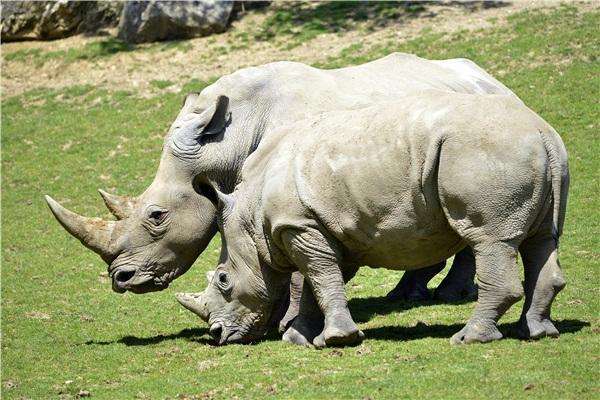Ceratotherium simum
IUCN
LCBasic Information
Scientific classification
- name:Ceratotherium simum
- Scientific Name:White rhino, square-nosed rhino, broad-nosed rhino
- Outline:Ungulata
- Family:Eutheria Perissodactyla Ceratopogonidae Rhinoceros Ceratotherium
Vital signs
- length:3.35-3.77 m
- Weight:1000-3600 kg
- lifetime:46-50 Year
Feature
It is one of the largest rhinos in existence and the second largest animal among terrestrial vertebrates.
Distribution and Habitat
The typical habitat of the white rhino includes dense forests, savannas, and grassy woodlands. White rhinos usually live near water sources. White rhinos are both diurnal and crepuscular, which varies according to the season. Historically, the northern white rhino's original range was northwestern Uganda, southern Chad, southwestern Sudan, eastern Central African Republic, and northeastern Democratic Republic of Congo. The southern white rhino was originally distributed throughout southern Africa. However, the current range of this subspecies is more restricted. The northern white rhino is only found in the Democratic Republic of Congo. The southern white rhino is found in Botswana, Namibia, Swaziland, Zimbabwe, Cote d'Ivoire, Kenya, and Zambia.
Appearance
The weight of an adult white rhino is about 1000-3600 kg. Compared to their body size, white rhinos have relatively small eyes, square lips, and a long neck with a hump. They have two horns of varying sizes. The longer horn is 1660 mm in length. In females, the horns are longer and thinner. The shorter horn can grow up to 550 mm in length.
White rhinos mainly feed on grass
A common behavior of white rhinos is their response to predators, for example, during running, all white rhinos constantly hit the ground with their hind feet and follow the running direction of other rhinos with their front feet. Other common behaviors include taking mud baths in the summer and sand baths in the winter. In winter, their peak activity time occurs during the day. In summer, the activity time of white rhinos is concentrated between 5 to 9 am and 3 to 6:30 pm. This shift is a way to avoid the hotter weather in the summer. White rhinos do not migrate from one place to another in different seasons.
Details
The white rhino is not white. In fact, the body color of the white rhino is not much different from that of the black rhino. The main difference is the larger body size and wide lips. The mouth of the white rhino is "flat", while the mouth of the black rhino is "pointed".

The name of the white rhino comes from the Dutch word "weit", which means "wide". In view of their wide lips, they were later mistakenly called "white", so they are called "white rhino", also known as "square-mouthed rhino". The genus name of the white rhino, Ceratotherium, comes from the Greek "cerato", meaning "horn" and "thorium", meaning "beast", and the species name simum comes from the Greek simus, meaning "flat nose".
The white rhino is the largest of the five existing rhinoceros species, with two subspecies, the southern white rhino and the northern white rhino.
On March 20, 2018, Sudan, the last male northern white rhino in the world, died in Kenya at the age of 45 (equivalent to 100 years old in human terms). The two northern white rhinos that are still alive are Sudan's daughter Najin (27 years old) and granddaughter Fatu (17 years old). So the northern white rhino is already functionally extinct.
White rhinos are also considered a keystone species because they help increase grass biodiversity and potentially prevent wildfires. Waldram et al. (2008) reported that white rhinos graze grasses so that wildfires cannot burn them. In addition, removing rhinos from grasslands has led to the loss of 50% of the short grass land cover in the area.
White rhinos are endangered species and, like black rhinos, face significant threats from poaching and habitat loss. White rhinos are particularly vulnerable to poaching for their horns due to their large size, poor eyesight, and the fact that they sometimes live in groups. Rhino poaching remains rampant due to the high black market value of their horns. Criminals often risk killing rhinos for money, even sneaking into zoos to kill captive rhinos. Instability in some African countries due to internal politics and war also contributes to poaching. In 2013. Poaching of white rhinos is even still twice as high as in previous years. In 2017, a zoo in France was invaded and its white rhinos were killed by poachers.
As of December 31, 2017, there were an estimated 18,064 white rhinos in the wild.








